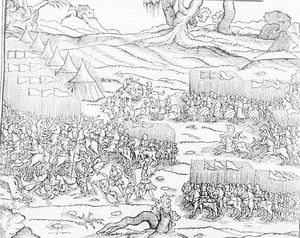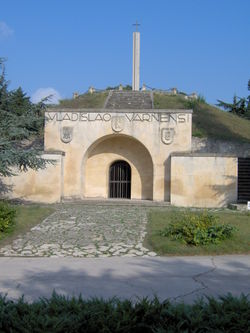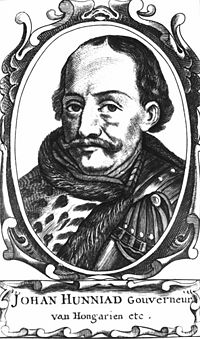Battle of Varna
| Battle of Varna | |||||||
|---|---|---|---|---|---|---|---|
| Part of the Ottoman wars in Europe Ottoman-Hungarian Wars |
|||||||
by Jan Matejko |
|||||||
|
|||||||
| Belligerents | |||||||
|
|||||||
| Commanders and leaders | |||||||
|
|
||||||
| Strength | |||||||
| ~ 20,000 | ~ 60,000 | ||||||
| Casualties and losses | |||||||
| Army was almost totally annihilated[1] | |||||||
|
|||||
|
|
|||||
The Battle of Varna took place on November 10, 1444 near Varna in eastern Bulgaria. In this battle the Ottoman Empire under Sultan Murad II defeated the Polish and Hungarian armies under Władysław III of Poland and János Hunyadi. It was the final battle of the Crusade of Varna.[2][3]
Contents |
Background
After failed expeditions in 1440-1442 against Belgrade and Transylvania, and the defeats of the "long campaign" of Janos Hunyadi in 1442/1443, the Ottoman sultan Murad II signed a ten-year truce with Hungary. After he had made peace with the Karaman Emirate in Anatolia in August 1444, he resigned the throne to his twelve year-old son Mehmed II.
Reneging on the peace treaty, Hungary co-operated with Venice and the pope, Eugene IV, to organize a new crusader army. On this news Murad was recalled to the throne by his son. Although Murad initially refused this summoning persistently on the grounds that he was not the sultan anymore, he was outwitted by his son who on the news of his refusal wrote to him: "If you are the sultan, lead your armies; but if I am the sultan, I hereby order you to come and lead my armies." Murad then had no choice but to reclaim the throne.
Preparations
A mixed Christian army consisting mainly of Hungarian and Polish forces, with smaller detachments of Czechs, papal knights, Teutonic Knights, Bosnians, Croatians, Bulgarians, Wallachians, Lithuanians, Serbs and Ruthenians (Ukrainians), met with a numerically superior Turkish army.
The Hungarians were ill-equipped, and promised support from Constantinople did not arrive. The Hungarian army was small and very imbalanced (because most of the Hungarian Magnates didn't support this campaign sufficiently). It contained almost no infantry, except three hundred Czech mercenary handgunners. There were one hundred war wagons with crews (Wagenburg). The rest of the army was heavy cavalry, mostly royal and foreign mercenaries, with some episcopal and nobles' banners as well.
Papal, Venetian and Genoese ships had blockaded the Dardanelles as the Hungarian army was to advance on Varna, where it would meet the Papal fleet and sail down the coast to Constantinople, pushing the Ottomans out of Europe. The Hungarian advance was rapid, Ottoman fortresses were bypassed, while local Bulgarians from Vidin, Oryahovo, and Nicopolis joined the army (Fruzhin, son of Ivan Shishman, also participated in the campaign with his own guard). On October 10 near Nicopolis, some 4,000 Wallachian cavalrymen under Mircea II, one of Vlad Dracul's sons, also joined.
Refugee Armenians in Hungary also took part in the wars of their new country against the Turks as early as the battle of Varna in 1444, when some Armenians were seen amongst the Christian forces.[4]
Deployment
Late on November 9, a large Ottoman army of around 40,000-60,000 men approached Varna from the west. At a supreme military council called by Hunyadi during the night, the Papal legate, cardinal Julian Cesarini, insisted on a quick withdrawal. However, the Christians were closed between the Black Sea, Lake Varna, the steep wooded slopes of the Franga plateau (356 m high), and the enemy. Cesarini then proposed defense using the Wagenburg of the Hussites until the arrival of the Christian fleet. The Hungarian magnates and the Croatian, Bosnian, and Czech commanders backed him, but the young (20-year-old) Władysław and Hunyadi rejected the defensive tactics. Hunyadi declared: "To escape is impossible, to surrender is unthinkable. Let us fight with bravery and honor our arms." Władysław accepted his position and gave him the command. Andreas del Palatio states that Hunyadi commanded the "Wallachian army" indicating a large Romanian component in Hunyadi's personal army.[5]
In the morning of November 10, Hunyadi deployed the army of some 20,000-30,000 crusaders as an arc between Lake Varna and the Franga plateau; the line was about 3.5 km long. Two banners with a total of 3,500 men from the king's Polish and Hungarian bodyguards, Hungarian royal mercenaries, and banners of Hungarian nobles held the center. The Wallachian cavalry was left in reserve behind the center.
The right flank that lined up the hill towards the village of Kamenar numbered 6,500 men in 5 banners. Bishop Jan Dominek of Varadin with his personal banner led the force; Cesarini commanded a banner of German mercenaries and a Bosnian one. The Bishop of Eger lead his own banner, and the military governor of Slavonia, ban Franco Talotsi, commanded one Croatian banner.
The left flank, a total of 5,000 men in 5 banners, was led by Michael Szilágyi, Hunyadi's brother in law, and was made up of Hunyadi's Transylvanians, Bulgarians, German mercenaries and banners of Hungarian magnates. Behind the Hungarians, closer to the Black Sea and the lake, was the Wagenburg, defended by 300 or 600 Czech and Ruthenian mercenaries under hetman Ceyka and Poles, Lithuanians and Wallachians. Every wagon was manned by 7 to 10 soldiers and the Wagenburg was equipped with bombards.
The Ottoman center included the Janissaries and levies from Rumelia deployed around two Thracian burial mounds. Murad observed and directed the battle from one of them. The Janissaries dug in behind ditches and two palisades. The right wing consisted of Kapikulus and Sipahis from Rumelia, and the left wing was made up by Akıncıs, Sipahis from Anatolia, Arab mercenaries, and other forces. Janissary archers and Akıncı light cavalry were deployed on the Franga plateau.
The battle

The light Ottoman and Arab cavalry assaulted the Croats of ban Talotsi. Christians from the left riposted with bombards and firearms and stopped the attack. Christian soldiers chased the Ottomans and Arabs in a disorderly pursuit. The Anatolian cavalry and Arabs on camelsambushed them from the flank. The Christian right wing attempted to flee to the small fortress of Galata on the other side of Varna Bay, but most of them were slain in the marshland around Varna Lake and the river Devnya, where Cesarini also met his end. Only ban Talotsi's troops managed to withdraw behind the Wagenburg.

Władysław and Hunyadi deployed two cavalry companies from the center and the Wallachian cavalry against the Arabs and Anatolian Sipahis, who were routed and their commander, the Anatolian beylerbey Karaca Bey, killed. The Christians pursued them for more than 5–6 km and then returned to the battlefield. The Wallachian cavalry continued the chase and broke into the fortified Ottoman camp. After pillaging and looting, the Wallachians overcharged with gold and other booty left the battlefield.
The other Ottoman flank assaulted the Hungarians and Bulgarians of Michael Szilagyi. Their push was stopped and turned back; then Sipahis attacked again. Hunyadi decided to help and advised Władysław to wait until he returned; then advanced with two cavalry companies against the Sipahis, defeated and pursued them toward the road to Shumen for 5–6 km. The Sipahis were so terrified that some of them reached and crossed the river Kamchiya some 30 km away.
At this juncture, the European army seemed close to victory, According to Edward Gibbon (The Decline and Fall of the Roman Empire), "When Amurath beheld the flight of his squadrons, he despaired of his fortune and that of the empire: a veteran Janissary seized his horse's bridle; and he had magnanimity to pardon and reward the soldier who dared to perceive the terror, and arrest the flight, of his sovereign."
The young king, ignoring Hunyadi's advice, rushed 500 of his Polish knights against the Ottoman center. They attempted to overrun the Janissary infantry and take Murad prisoner. But the cavalry charge was stopped and the king slain by the unyielding Janissary bodyguards, his head was cut off and later taken to the Ottoman court. The remaining Polish cavalry was smashed by the Ottomans.
On his return, Hunyadi tried frantically to salvage the king's body but all he could accomplish was to organize the retreat of the remains of his army. It suffered 11,000-13,000 casualties. The Ottomans lost 8,000 soldiers. . Many European prisoners were slaughtered or sold as slaves; the minnesinger Michael Beheim wrote a song based on the story of one Hans Mergest who spent 16 years in Ottoman captivity after the battle.
Aftermath
The death of Władysław left Hungary in the hands of the four-year-old Ladislaus Posthumous of Bohemia and Hungary. The defeat also set the stage for the fall of Constantinople in 1453.
- See also: Second Battle of Kosovo
Legacy

In an expression of gratitude, the Bulgarian people affectionately gave Władysław the name Варненчик (Varnenchik, Polish: Warneńczyk), after the city where he fought and died. In the 1930s, a cenotaph was erected by a Varna civic committee in a park on the former battleground. In the 1960s, a museum containing weapons and armor from the epoch was added, along with symbolic sarcophagi bearing the modern coats of arms of the countries participating in the battle on the European side. The park museum is currently within city limits; the urban municipality that contains it, as well as a central city boulevard are named after Władysław Warneńczyk. Another avenue is named after John Hunyadi.
Władysław has another grave in the cathedral on the Wawel (castle) hill in Cracow, Poland. But both graves are symbolic. After the battle his body was never found and it probably remained unrecognized and was buried along with the other slain knights. There was a legend that he was buried in an Orthodox church in Varna, which was demolished and replaced in 1602 by the Theotokos Panagia that is still standing.
References
- ↑ The last centuries of Byzantium, 1261-1453, Donald MacGillivray Nicol, page 363, 1993
- ↑ Bodnar, Edward W. Ciriaco d'Ancona e la crociata di Varna, nuove prospettive. Il Veltro 27, nos. 1-2 (1983): 235-51
- ↑ Halecki, Oscar, The Crusade of Varna. New York, 1943
- ↑ Basmadjian, Histoire moderne des Armeniens, Paris, 1922, p. 45
- ↑ Istoria Romaniei, Vol II, p. 440, 1960
External links
- Battle map (Hungarian)
- Imber, Colin (July 2006). The Crusade of Varna, 1443-45. Ashgate Publishing. ISBN 0-7546-0144-7. (Available online: Introduction (PDF))
|
||||||||||||||||||||||||||||
|
|||||||||||||||||||||||||||||||||||||||





